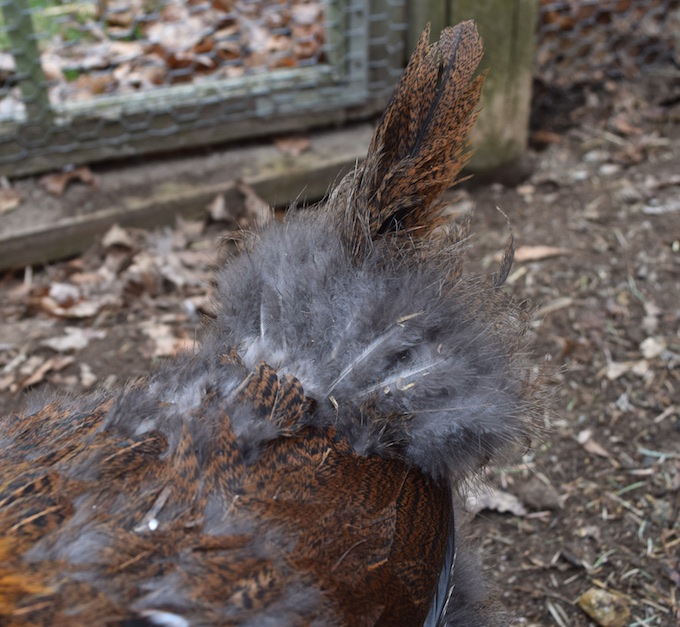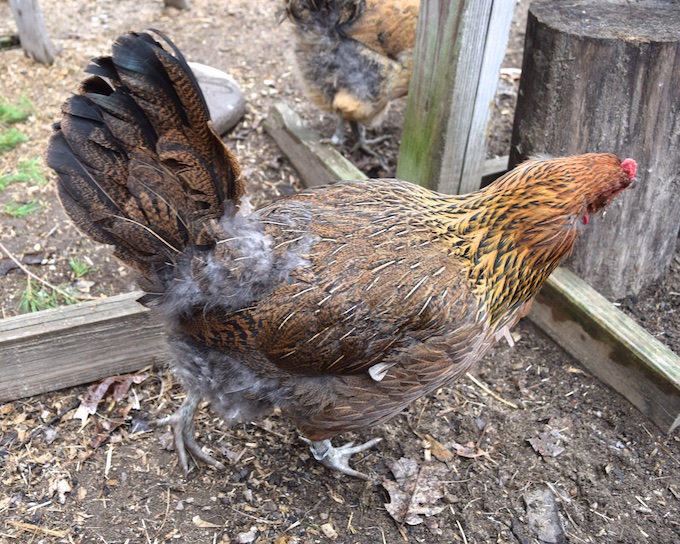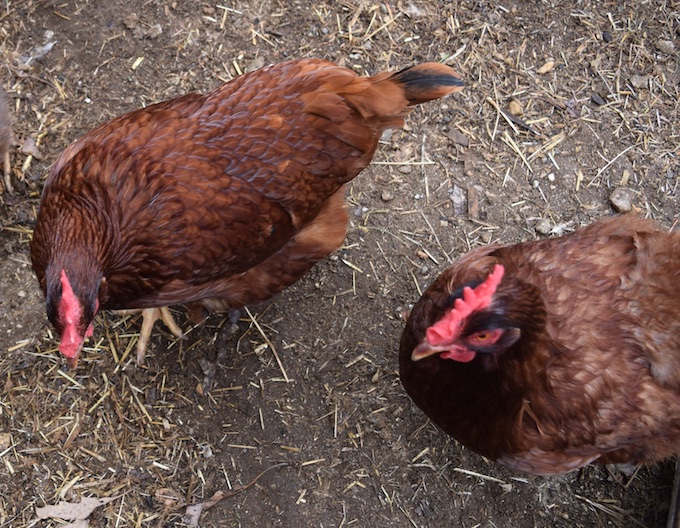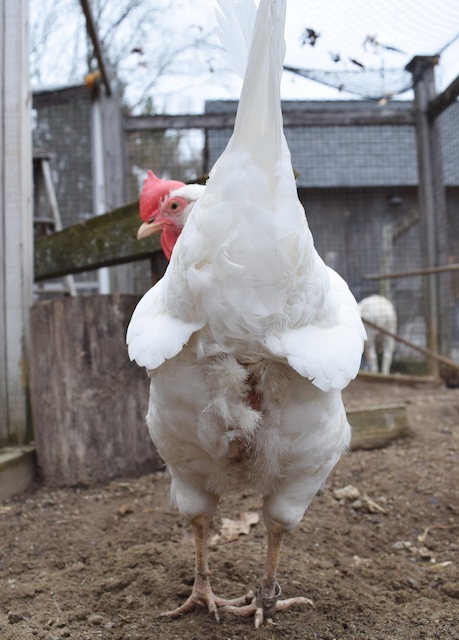Spring is here, but we’ll see the effects of the hard winter for months to come. I’m not speaking about my garden, but rather my hens. Confinement, lack of loose dirt to scratch in, and boredom, leads to feather picking. Sometimes this is associated with bullying and aggression, but often it’s not. It’s a social behavior that relieves stress. Some hens, like Jasper, actually encourage the other hens to peck at the feathers at the base of her tail.
Owly’s feathers have been broken off by her flock mates.
Veronica prefers to have her neck feathers removed. She also lets the feathers near her vent get pecked at.
Some hens don’t take part in the pecking party. Misty doesn’t stand still long enough, and for whatever reason, Amber, the Buff Orpington, is as gorgeous as ever.
Although the breed of the hen can be a contributing factor to the likelihood of being pecked (or being the offending pecker), that’s not always the case. Of my two Rhode Island Reds, only one has damage, the other doesn’t have a single broken feather.
Hens grow new feathers only once a year. First they molt their old feathers (they drop off) and then new ones come in. This happens in the late summer and into the winter. (They stop laying at this time.) So, the roughed-up feathers that my hens now sport will be retained until autumn of next year. I’m going to have a scruffy-looking group.
There’s always the exception to the rule, and in my flock it is Twiggy. Twiggy did not molt with the others. She kept laying. She’s still laying – not daily, but she hasn’t had a break. Recently, though, I’ve noticed that she’s missing the feathers around her vent. No one gets near this fast and busy hen. It’s not feather picking. I think it’s a molt. Unique to her.
If the feather-picking had turned nasty, if skin showed, if blood was drawn, I would have intervened. I would have reevaluated housing and feed. I might have separated out the most avid of the feather-pickers. But, my flock remained peaceful and healthy. I let them be. If I took these birds to poultry shows, their feathering would be totally embarrassing. But, in my backyard, they’re fine. Spring is here. They have better things to do.







Another great article…grateful for the ifs at the end of the article for people who might have bigger issues going on. While I thought I might have mites earlier in the spring this year, it turned out not to be the case as I finally witnessed that it was merely an esthetician at work; two hens have been having their chin hairs quite gently removed…..
Considering how bad your winter was, I’d say the lack of real damage shows just how well what you do works.
Poultry shows are ok I suppose. I prefer “egg tally” shows…..and it’s associated recipe shows.
Recipe shows? Fun!
Terry,
I saw the black hen pecking at Twiggy’s bottom one day . She was following Twiggy around and every time she stood still she got plucked. Even when she was on the ladder, the other hen was after her bottom feathers.
Darn. That’s Beulah. I took her back from the nursing home because she was a terrible feather picker. She became reformed in my coop, but this winter has set her back.
I have dealt with this with my hens for years. They are old enough now that they have calmed down sufficiently (they’re all geriatric!) and they don’t do it much anymore so we came through the winter with most, if not all feathers intact. I found that with mine, the least popular hens never were picked because no one wanted to “hang out” with them and the most dominant hens were not picked because they were the ones doing all the picking. Over this last year, four of my Production Reds (Matilda, Rhoda, Amelia and Hazel) died or were euthanized and they were my main picking offenders. Now everyone looks pretty good, even Prudence who had a bare behind for years! With mine, too, it was mostly a cosmetic issue and finally I learned to just let it be.
Good observations, and good attitude!
With such a bad winter you must be pleased the damage is minimal shows your system works. Our girls have not been confined this winter but it has been very wet, we solved the problem buy building extra covered areas.
My two Magpie hens which are a Barred Plymouth Rock / White Rhode cross are doing exactly the same as Twiggy there egg laying has slowed but never stopped and they are losing their feathers a few at a time. I am intrigued by Owly her colouring and pattern lay out are the same as my Welsummer, do you know what her mix is ? :)
Owly is an Ameracauna, which is a version of the purebred Araucana. Varied feathers, varied egg colors.
Ah, yes, spring is here. Guess who I saw sitting on the roost cleaning itself on your barncam? It wasn’t a chicken! You might want to check for nests in the rafters.
An on-going battle to keep the sparrows out of the barn.
…like two old horses that chew on each other’s tails!
I get much more upset by horse tail chewing than feather picking!
Terry …… what do you think about Forco? I was told that it helps with feather picking and overall good digestive health. I’m always afraid to add anything new to my hens diet ….. I wasn’t sure if you had any knowledge of this product? http://forcocolorado.com/wp/forco-avians-chickens-turkeys/
I don’t know this product, but I followed the links. It’s simply a yeast product that acts as a pre-and probiotic. I doubt that it helps feather picking as I’ve described, as what my hens are doing is social, not due to nutritional imbalances. The Poulin pellets that I feed have a similar product in it. Stressed animals, and those recently on antibiotics might benefit, otherwise I wouldn’t bother.
I bought you a cup of coffee for helping me. My hen had diarreha for 5 or 6 days and I thought I was going to lose her. I was giving probiotics and elecrolites. You had a post on here about giving Epsom salts and I did it two days in a row and she is almost back to normal. I am so happy because she is a pet. I only have 2 hens. Posy is almost 3 years old and Sally is 2. Thank you for your help